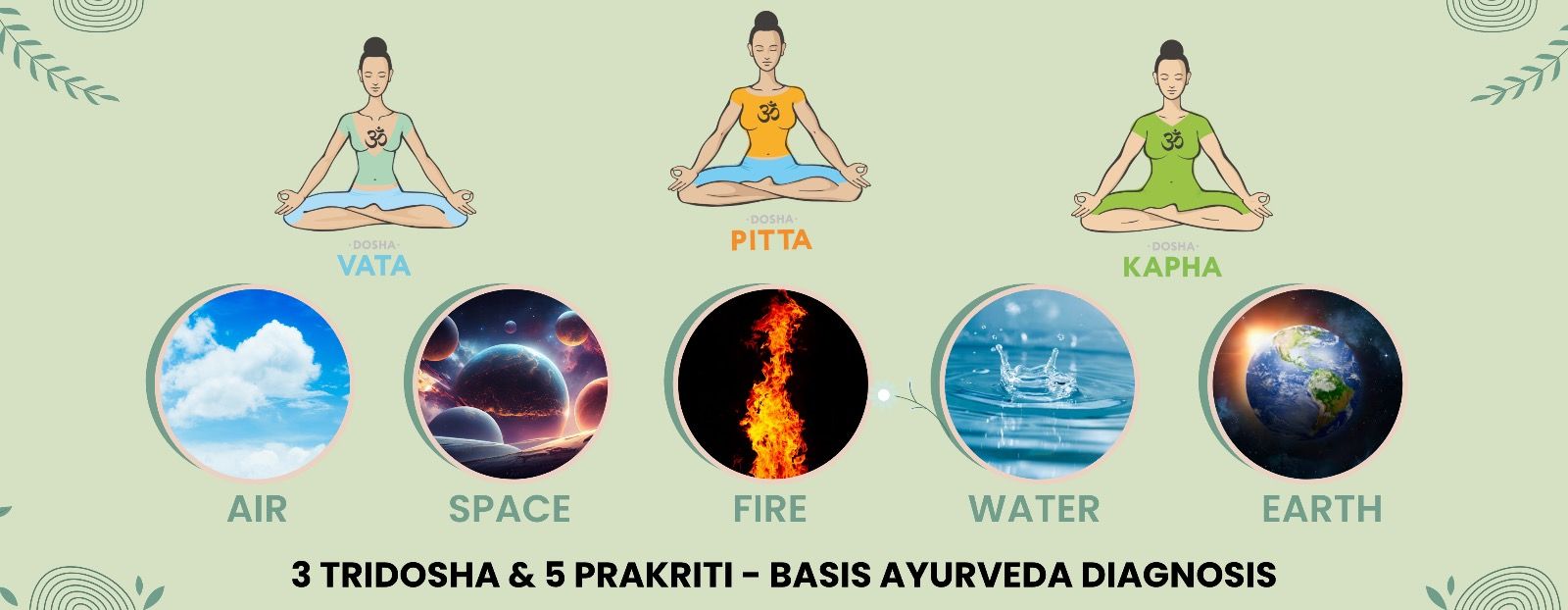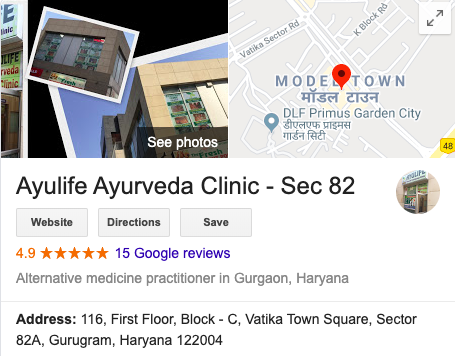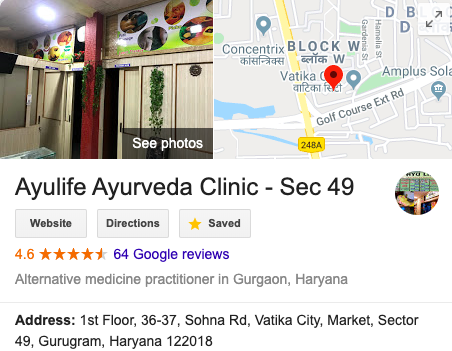
What is Ayurveda
How Ayurveda Treats?
Ayurveda is the most ancient therapy, all across the world. Its about 5000 years old, first time mentioned in the Rigveda. It literally means knowledge of life. The word Ayurveda is the combination of two words Ayu and Veda.
AYU means LIFE & VEDA means KNOWLEDGE
As per Rigveda, following are 2 basic principles of our constitution:
- PanchaMahabhut
- Tridoshas
5 Elements (PanchMahabhut) in Ayurveda
According to Ayurveda, each individual is structurally composed of Five basic elements of Universe and these elements relate to 5 basic senses as indicated :-
- Akash : For Hearing or ear and is represented by sound ( Sense)
- Air : It represents “Touch” sense is responsible for the respiratory system.
- Fire : It is responsible for digestion and perception/Eye Sight
- Water : It is responsible for fluid in the body or Taste through tongue.
- Earth : Represents Smell sense or Nose.
Humors (Tridoshas) in Ayurveda & Body Prakurati
The functional aspect of the body is governed by three biological humors. Each individual has unique characteristic of VPK which is decided at time of its birth. Like the poison is natural and inherent to poisonous insects, similarly, the Prakruti (body type) is inherent to humans. The body type is decided during conception, based on qualities of sperm and ovum.
As per our great texts on Ayurveda – Ashtang Haridya.
शु ातवथै: जमादौ वषेणैव वषकृमे: ॥ तैच त: कृतयो हनमयोतमा: पथकृ ् । समधात: समतास ु ु ेठा नया वदोषजा ॥
śukrārtavasthai: janmādau viṣeṇaiva viṣakṛme: || taiśca tisra: prakṛtayo hīnamadhyottamā: pṛthak | samadhātu: samastāsu śreṣṭhā nindyā dvidoṣajā ||
Meaning : As poison is inherent to poisonous insects, similarly, the Prakruti (body type) is inherent to humans. The body type is decided during conception stage itself and is based on qualities of sperm and ovum.
The balance and imbalance of Doshas lead to the condition of being healthy or diseased.
वायु: पतं कफचेत यो दोषा: समासत: ॥ वकृताऽवकृता देहं नित ते वतयित च ।
vāyu: pittaṃ kaphaśceti trayo doṣā: samāsata: || vikṛtā’vikṛtā dehaṃ ghnanti te varttayanti ca |
VVata, Pitta and kapha are the three Doshas of the body. Perfect balance of three Doshas leads to healthy life while imbalance in Tridosha leads to diseases.
- Vata —a combination of ether and air & Responsible for movement in the body
- Pitta—a combination of fire and water & Governs digestion.
- Kapha—a combination of water and earth & Responsible for body fluids
The Tridosha are present all over the body, but their presence is especially seen in particular parts. If you divide the body into three parts, the top part upto chest is dominated by Kapha Dosha, between chest and umbilicus/Navel is dominated by Pitta, below umbilicus part/Navle is dominated by Vata.
Treatment in Ayurveda
Broadly these are the major steps in Ayurveda treatment:
- Nidaan Parivarjan: In Nidaan Parivarjan the causative Factors or the problems which lead to origin of disease are controlled. These causative factors are controlled by changes in lifestyle like Dietary or other Routine works.
- Shaman Chikitsa: Medicines are given to treat the disease or imbalance in Dosha. These are herbal medicines.
- Shodhan Chikitsa: Purification Procedure or Panchakarma Procedures in which the imbalanced Dosha is eliminated from the body. These are recommended to patient based on the imbalanced Doshas.
Panchakarma means “Five Procedures”. These five cleansing procedures remove accumulated waste materials in the body. Meant for both healthy and sick.
- Vamana – Induce vomiting with Medicine
- Virechan – Cleaning the Bowel with Medicines
- Basti – Medicated oil Enema in Rectal Column
- Nasyam – Instilling Medication through Nose
- Leech Therapy – Blood Purification
Ayurveda comprehends Body, Mind and Spirit equally Hence Ayurveda treatment works on all.
त ो लघु: शीत: खर: सू मचलोऽनल: ॥
tatra rūkṣo laghu: śīta: khara: sūkṣmaścalo’nila: ||
These are the parameters or qualities of Vata Dosha:
- Rooksha – dryness
- Laghu – Lightness
- Sheeta – coldness
- Khara – roughness
- Sookshma – Short
- Chala – movement
Functions or Characteristics of Vata Dosha
तंचलः उसाहोवास नवास चेटावेगवतनैः सयगया च धातनां ू अाणांपाटवेन चअनु गणात ृ अवकृतः
- Vata Dosha regulates respiration process,
- Vata is responsible for all movements.
- Movement of blood in blood vessels, nutrients, air in lungs etc
- Locomotion movements of hands and legs etc.
- Regulates all activities of mind, speech.
- Initiation of natural urges like Tears, faeces, urination, sneezing, coughing, vomiting yawning.
- Maintenance of the Dhatus (tissues) in their normalcy and proper functioning of the sense organs.
Effects of increase or Decrease in Vata on body
वत ृ ुकुतेअनलः कायकायउनकामवकपानाशकृहान् बलनेियंशलापमदनताः
Affects on Body When Vata Dosha increases, it produces :-
- Karshya– emaciation,
- Karshnya– black discoloration,
- Ushnakamitva– desire for hot things,
- Kampa– tremors
- Anaha– bloating, fullness, distention of the abdomen,
- ShakrutGraha – constipation,
- Balabhramsha – loss of strength,
- Nidrabhramsha – loss of sleep
- Indriyabhramsha – loss of sensory functions,
- Pralapa– irrelevant speech,
- Bhrama– Delusion, Dizziness giddiness
- Deenata– timidity (peevishness).
Affects on Body When Vata Dosha decreases, it produces :-
लगंीणेअनलेअगय सदो अप भाषतेहतम ् संामोहतथा लेमवय ृ ु तामाशायसभवः
- Angasada– debility of the body,
- Alpa bhashite hitam– the person speaks very little
- Sanjna moha– loss of sensation (awareness) and of consciousness
पतं सनेह तीणोणं लघु वं सरं वम ।
् pittaṃ sasneha tīkṣṇoṣṇaṃ laghu visraṃ saraṃ dravam
- Sasneha– slightly oily, unctuous,
- Teekshna– piercing, entering into deep tissues,
- Ushna– hotness,
- Laghu– lightness,
- Visram– bad smell,
- Sara– having fluidity, movement,
- Srava– liquidity are the qualities of Pitta.
Functions or Characteristics of Pitta Dosha
पतंपयूमदशनैः ुतृ चभामेधाधीशौयतनु मादवैः
In its normal state, Pitta causes:
- Digestion and metabolism.
- Maintenance of body temperature,
- Maintains vision,
- Causes hunger,
- Thirst, appetite,
- Maintains skin complexion,
- Gives Intelligence, courage, valour
- Leads to softness (suppleness) of the body.
Effects of increase or Decrease in Pitta on body
Effects of increase of Pitta
पीतवमू नेवुतदाहापनताः ृ पतम ्
Pitta when increased produces
- Yellow discoloration of the faeces, urine, eyes, and skin;
- Excess of hunger and thirst,
- Feeling of burning sensation and very little sleep
Decreased Pitta causes
पते मदो अनलः शीतं भाहानः
- Mande anala – weakness of digestive activity,
- Shaitya – coldness
- Prabha hani – loss of luster (complexion)
- Snigdhna – oily, unctuous, Sheeta – cold,
- Guru – heavy,
- Manda – mild, viscous,
- shlakshna – smooth, clear,
- Mrutsna – slimy, jely,
- sthira – stability, immobility
Functions or Characteristics of Kapha Dosha
- Kapha confers stability, lubrication, compactness (firmness) of the joints,
- Kshama – It is the cause for mental capacity to withstand or withhold emotions, strains etc. It is also cause for forgiveness.
Effects of Increase or Decrease in Kapha on body
लेमा अिनसदनसेकालयगौरवम ् वैयशैयशलथागवं वासकासातनताः Kapha, when increased produces- Agnisadana – weak digestive activity,
- Praseka – excess salivation,
- Alasya – lassitude, laziness
- Gaurava – feeling of heaviness,
- Shvaithya – white discoloration,
- Shaithya – coldness,
- Shlathangatva – looseness of the body parts,
- Shwasa – dyspnoea, asthma, COPD
- Kasa – cough, cold
- Atinidrata – excess of sleep
Decrease of Kapha causes
कफे मः लेमाशयानां शू यवं वः शलथसिधता- Bhrama – Delusion, Dizziness,
- Shunyatva – emptiness of the organs of Kapha,
- Shrudrava – tremors of the heart (palpitation)
- Shlatha sandhita – looseness of the joints

















